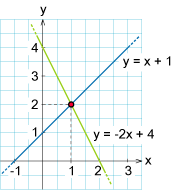2. Algebra
Aus Online Mathematik Brückenkurs 1
| \displaystyle \text{@(a class="image" href="http://smaug.nti.se/temp/KTH/film4.html" target="_blank")@(img src="http://wiki.math.se/wikis/2008/forberedandematte1/img_auth.php/0/00/Lars_och_Elin.jpg" alt="Film om algebra")@(/img)@(/a)} |
Why do we use letters and who were the first to do this?
Watch the video in which the lecturer Lasse Svensson tells us how algebra
developed and answers Elins questions about Part 2 of the course.
Algebra ist ein Teilgebiet der Mathematik das dass rechnen mit unbekannten Symbolen enthält, und nicht nur Zahlen.
Algebra kann zu vieles verwendet werden. Zum Beispiel können geometrische Probleme oft in algebraische Probleme umgewandelt werden, und mit hilfe von Algebra auch gelöst werden.
In manchen Fällen kann man Ausdrücke nicht exakt berechnen. Der Ausdruck kann zum Beispiel unbekannte Parameter oder Vaiablen enthalten. Es kann auch so sein dass der ausdruck nicht exakt dargestellt werden kann, sowie zum Beispiel der Umfang eines Kreises (\displaystyle 2\pi r), oder die Hypotenuse eines Dreiecks (\displaystyle \sqrt{3} zum Beispiel). Es kann sich auch einfach um einen Konstant handeln, der zum Beispiel \displaystyle \dfrac{1-\ln 2}{3} sein kann.
Deshalb kann es einfacher sein eine Zahl mit einen Symbol zu repräsentieren, wie zum Beispiel a. Die Lösung einer Gleichung mit a, wird dann aber keine Zahl enthalten, sondern einen Ausdruck der a enthält.
Eine häufige Anwendung von Algebra ist die Vereinfachung von Ausdrücken. Vereinfachte Ausdrücke sind sehr anwendbar wenn man zum Beispiel eine Gleichung differenziert, oder wenn man eine Gleichung löst.
Durch Vereinfachungen vermeidet man oft Rechenfehler. Eine Vereinfachung zu machen bedeutet dass man eine Gleichung zu einer anderen transformiert. Welche Gleichung am &rdquo:einfachsten” ist, ist oft offenbar, aber hängt manchmal von der Situation ab.
Wenn man einen Ausdruck differenziert, ist es oft ein Vorteil wenn der Ausdruck aus einer Summe von mehreren Termen besteht. Wenn man aber eine Gleichung lösen möchte, ist es öfter ein Vorteil wenn der Ausdruck aus ein Produkt von mehreren Faktoren besteht. Deshalb ist es wichtig Algebra gut zu beherrschen, um Ausdrücke transformieren zu können.
Dieser Abschnitt, sowohl wie alle anderen, voraussetzen dass Sie keinen Taschenrechner verwenden.
In der Universität sind Taschenrechner bei den Prüfungen nicht zugelassen, zumindest nicht in den Grundkursen.
Um den Abschnitt Algebra zu bestehen
- Lesen Sie zuerst den Theorieabschnitt und lesen Sie die Beispiele durch.
- Work through the exercises and try to solve them without using a calculator. Make sure that you have the right answer by clicking on the answer button. If you do not have it, you can click on the solution button to see what went wrong
- Then go ahead and answer the questions in the basic test of the section.
- If you get stuck on a point, check to see if someone else has discussed the point in the forum belonging to the section. If not, take up the point yourself. Your teacher (or a student) will respond to your question within a few hours.
- When you are finished with the exercises and the basic test in a section you should take the final test to get a pass for the section. The requirement here is to answer correctly three questions in a row before you can move on to the next section.
- When you have answered correctly all questions in both the basic and the final test of this section you will have a pass for this section and can move on to Part 3 of the course.
P.S. If you feel that you are very familiar with the contents of a section you can test yourself by going directly to the basic and final tests. You must answer all the questions correctly in a test, but you may do the test several times if you do not succeed at the first attempt. It is your final results which appear in the statistics.

